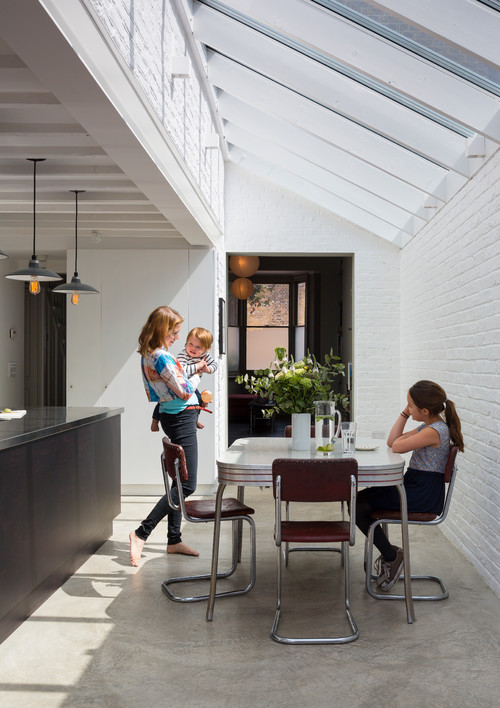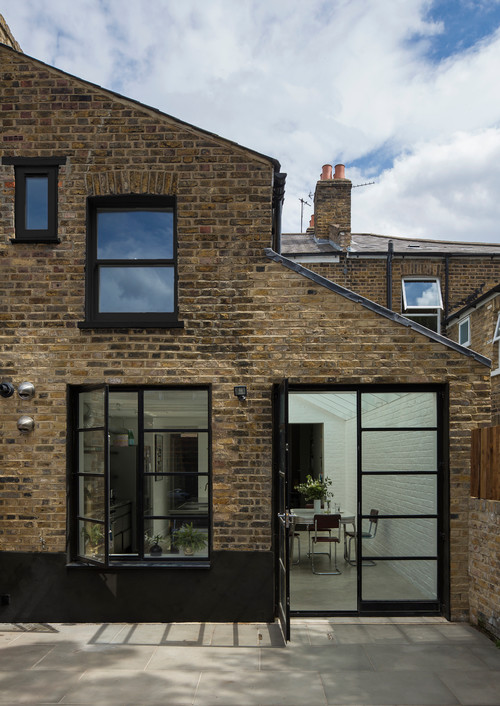
This period property in Peckham embraces industrial style and exposed materials with a new, light-filled, open-plan layout that lends it the feel of a modern Manhattan loft-conversion. Take the Houzz tour…
Words: Lara Sargent, Houzz Contributor
This article was first published on Houzz
Room at a Glance
Who lives here A young family
Location Peckham, south London
Size Kitchen-diner is approximately 30 sq m; part of a Victorian house with 3 bedrooms and 2 bathrooms
Architect John Norman of Mustard Architects
Builder Gebouw Design & Build
Photography Tim Crocker
When the owners of this traditional Victorian terrace in Peckham, south London, moved in, they had ambitious plans for it.
‘Our clients had a clear idea of achieving a New York-style industrial warehouse space within a Victorian London home,’ says John Norman, director of Mustard Architects, who worked on the project for just over a year. ‘Part of our job was to pull together all the different elements and details to make the space feel distinctive and work as a greater whole.’
– Discover contemporary dining room design inspiration The primary focus with this project was to open up the rear kitchen and dining space and extend into the side return. ‘The whole area under the glass roof used to be external,’ says architect John Norman. ‘We achieved Planning Permission for a full infill side extension to make the enlarged kitchen-diner. The aim was to create an elegant yet industrial space with a timeless quality to it.’  Photo by Mustard Architects – Look for contemporary home design pictures Kitchen joinery, Hexagon Furniture. Worktops, MPN Engineering Services. Pendant lights, Barn Light Electric
Photo by Mustard Architects – Look for contemporary home design pictures Kitchen joinery, Hexagon Furniture. Worktops, MPN Engineering Services. Pendant lights, Barn Light Electric
The kitchen and dining area at the back of the property were originally much smaller, and felt dark and disconnected from the living spaces. The new kitchen was designed bespoke by Mustard Architects and handmade by a joiner. It combines stained birch plywood cabinet fronts with stainless-steel worktops, and has an integrated sink for a seamless finish that has a distinct urban-industrial look. ‘We used stained birch plywood to create a bespoke, textured finish,’ explains Norman. ‘It’s an easy material to work with and has straightforward yet elegant details.’  Photo by Mustard Architects – Discover contemporary home design design inspiration Range cooker and cooker hood, Falcon
Photo by Mustard Architects – Discover contemporary home design design inspiration Range cooker and cooker hood, Falcon
Norman opted for exposed ductwork because it enhances the industrial vibe of the space. ‘We used off-the-shelf rigid metal ductwork, which the contractor installed on site,’ he says.
‘Cooking was another important aspect for our clients and we helped them look through various cooker options before they settled on a Falcon range and hood.’
– Discover contemporary dining room design inspiration Rooflight, Lonsdale
A glazed roof was a key requirement of the clients’ brief and part of the design from the beginning. ‘We had to work closely with the builder to discuss how the new structure would integrate with the old,’ Norman explains.
The clients wanted to expose the existing floor joists above the main kitchen area to create an interesting ceiling feature.
‘We ran with the idea by using oversized, rough-cut timber rafters for the rooflight supports in the extension,’ adds Norman. ‘We could have used standard aluminium rafters, but these wouldn’t have been appropriate due to their smooth and square finish. Instead, we specified rough timbers to match the finish of the floor joists, and oversized them so they they became a strong element within the space.’
All the exposed brickwork and beams were then simply painted white. This not only kept the costs down, it also helped to achieve a textured industrial backdrop without too much fuss. ‘The paint worked to unify all the different materials while keeping their raw finish,’ the architect adds.
The retro-style dining table and chairs were picked up from a second-hand shop by the clients while they were living in New York.
– Browse contemporary kitchen photos
The architect chose a concrete floor to add to the raw, industrial feel of the space. ‘It’s a power-floated concrete floor, which involves a high-speed mechanical process of trowelling the concrete to leave a smooth and level finish, which we left untinted and treated with a satin sealant,’ says Norman.
– Discover contemporary home design design ideas
The openings between each room were widened and kept free of any doors to allow as much light as possible to filter through. It strikes a balance between modern, open-plan living and traditional, individual rooms.
‘The house has a fairly straightforward, open layout on the ground floor,’ says Norman. ‘We created a procession of spaces, from the front living room through to the rear living room [in the middle of the house] into the kitchen-diner and out into the garden.
‘There’s an awesome sense of space and light that hits you when moving from the front of the house to the rear. When in the dining space, you have a view out to the garden, back to the living room, across to the kitchen and up to the sky and, at night, the stars,’ he adds.
– Browse contemporary home design ideas Paint, Colour Makes People Happy
The front living room has a simple edit of furniture. ‘We closed off direct access to the front living room from the hallway to make it an end destination, accessed from the middle of the house, and to improve the furniture layout,’ says Norman.
The existing floorboards were sanded back and stained, and now echo the stained cabinetry in the kitchen.
‘The wall colours were chosen to contrast with the bright, light kitchen space and respond to the traditional nature of the house,’ Norman adds.
– Browse contemporary home design photos Crittall doors and window, Metwin
The rear doors and windows were previously white uPVC double-glazed units and a long way from what the clients desired. They were replaced with low-profile, Crittall steel frames in keeping with the industrial feel of the rest of the space.
‘Conventional aluminium frames, doors and windows would have likely had frames at least double or even three times the width,’ says Norman.
– Browse contemporary exterior photos External paving, Mandarin Stone
The back of the house merges traditional architecture with the industrial-style, low-profile glazing bars.









Comments: Our rules
We want our comments to be a lively and valuable part of our community - a place where readers can debate and engage with the most important local issues. The ability to comment on our stories is a privilege, not a right, however, and that privilege may be withdrawn if it is abused or misused.
Please report any comments that break our rules.
Read the rules here